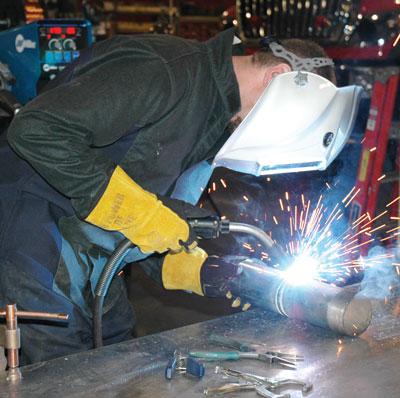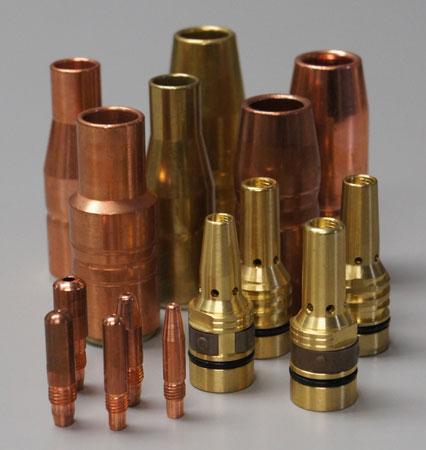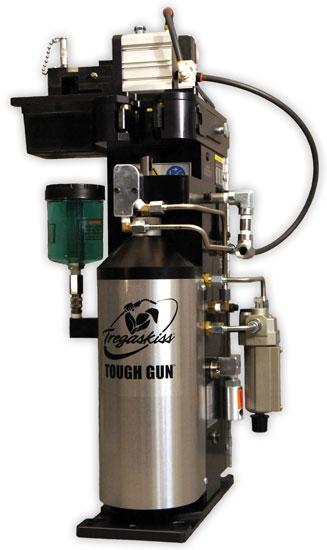Technical Specialists
- FMA
- The Fabricator
- FABTECH
- Canadian Metalworking
Categories
- Additive Manufacturing
- Aluminum Welding
- Arc Welding
- Assembly and Joining
- Automation and Robotics
- Bending and Forming
- Consumables
- Cutting and Weld Prep
- Electric Vehicles
- En Español
- Finishing
- Hydroforming
- Laser Cutting
- Laser Welding
- Machining
- Manufacturing Software
- Materials Handling
- Metals/Materials
- Oxyfuel Cutting
- Plasma Cutting
- Power Tools
- Punching and Other Holemaking
- Roll Forming
- Safety
- Sawing
- Shearing
- Shop Management
- Testing and Measuring
- Tube and Pipe Fabrication
- Tube and Pipe Production
- Waterjet Cutting
Industry Directory
Webcasts
Podcasts
FAB 40
Advertise
Subscribe
Account Login
Search
Consumables for high-amperage welding
5 tips to minimize downtime, costs, and quality risks in these heavy-duty welding applications
- By Dan Imus
- July 7, 2014
- Article
- Arc Welding

Figure 1
Tips for combating the harsh nature of high-amperage
welding apply to all forms of welding, whether it’s a semiautomatic
or robotic application.
Welding is a tough business requiring equally tough equipment. This is especially true when it comes to high-amperage applications.
Applications exceeding 300 amps generate a large amount of reflective heat from the arc, making it necessary to use front-end consumables—nozzles, contact tips, and gas diffusers—that can withstand the course of welding (see Figure 1). Such applications are particularly common in industries such as heavy equipment manufacturing, where the material thicknesses are greater and require the higher amperages to create quality welds. In some automotive applications that employ robotic welding systems, amperages also can be very high.
The right consumables can help in high-amperage applications in a number of ways. They can:
- Minimize downtime by preventing premature failures.
- Reduce consumables inventory and replacement costs.
- Prevent quality issues that require costly rework or result in scrapped parts.
- Reduce the risk of damage to the gas metal arc welding (GMAW) gun caused by heat buildup.
The key is to know the factors that negatively affect consumables, ways to extend the life of these components, and what options are available to gain the best results in a given application. Following are some tips to help along the way.
1. Go Heavy-Duty
For high-amperage applications, heavy-duty consumables are typically a good choice. These consumables have a greater mass than standard-duty consumables, allowing for better heat resistance for a longer period of time (see Figure 2).
Heavy-duty consumables come in a variety of materials and sizes. For example, heavy-duty contact tips are available in copper or chrome zirconium and feature an outside diameter (OD) of around 0.3125 inch. Nozzles are typically available in brass or copper. The brass variety tends to be more spatter-resistant; however, these nozzles can deteriorate more quickly than copper if they come in contact with the molten weld pool.
Extra-heavy-duty consumables are also available and are good choices for high-amperage applications requiring larger-diameter welding wires—0.052 in. and greater. Contact tips falling in this category generally have an outer diameter of about 0.375 in.
In some cases, standard-duty consumables can take the place of heavier-duty consumables, but it’s important to test them for durability in a given application before implementing them in the welding operation. For example, in applications with low duty cycles, heat generation is also low because less time is spent welding. Less heat can help to minimize the negative impact on the consumables. When frequent consumable changeover is a company protocol, standard-duty consumables could work in a high-amperage application; the welding operator can change them over before a failure occurs from the high heat levels.
Whether the consumables are heavy- or standard-duty, the welder is best off using consumables that are well-machined and have smooth, round surfaces. These higher-quality consumables are less prone to collecting spatter and tend to last longer.
2. Be Aware of the Welding Mode
Mechanical wear on the contact tip is inevitable in any welding application. The constant friction of the welding wire feeding through the tip wears away at it.

Figure 2
In essence, the greater mass of heavy-duty consumables
acts as a heat sink, pulling the heat from the arc away from
the contact tip, nozzles, and gas diffusers.
In high-amperage welding employing a pulsed welding mode, electrical wear also can be an issue. Pulsed welding programs have a unique waveform that causes the power source to move between low background currents and high peaks, which is particularly harsh on consumables. Heavy-duty or chrome zirconium contact tips are a good choice for this welding process.
It is also a good idea to monitor contact tip usage regularly in pulsed welding applications. Changing over contact tips before they are too damaged can help to prevent issues such as loss of electrical conductivity, burnbacks, and excessive spatter, resulting in poor weld quality, rework, and downtime. Welders can use the time during routine breaks in production for contact tip changeover to maximize efficiency.
3. Invest in Peripherals for Robotic Welding
For robotic welding applications, peripherals such as a nozzle cleaning station (or reamer) are important pieces of equipment to extend consumable life (see Figure 3), particularly in high-amperage processes. A nozzle cleaning station cleans the robotic gun and nozzle of spatter and also clears away any debris in the retaining head that may have accumulated during welding.
These stations also can be outfitted with a sprayer that applies a water- or oil-based antispatter compound to protect the nozzle, retaining head, and workpiece from spatter after it has been cleaned.
For high-amperage applications, it is especially important to program the robot to go to the nozzle cleaning station more frequently than in a lower-amperage job. Because high amperage generates more heat, spatter tends to adhere more readily to the consumables. Also, the brief time away from the arc gives the consumables time to cool down, which can help extend their lifespan.
As a side note, the nozzle cleaning station should be placed close to the robot so it is easily accessible and be programmed for the robot to use in between cycles—during part loading or tool transfer, for example. This timing helps minimize interruptions to the welding operation.
4. Check the Connections
Sound connections between consumables are critical in any welding process, but they are especially important in high-amperage applications because they help to minimize resistive heat, ensure strong electrical conductivity, and reduce the potential for premature failure.
The goal is to select high-quality consumables that seat precisely together, offering a strong attachment between the nozzle, contact tip, and gas diffuser. This connection helps pull heat away from the consumables by creating a greater amount of mass to manage the heat from the high-amperage welding arc. It also is important to check the consumables regularly for tight connections and follow the manufacturer’s instructions for installation.
5. Consider the Impact of Welding Wire
When it comes to matching the contact tip diameter to the wire diameter in high-amperage operations, the welder needs to defer to some general best practices that are also common in lower-amperage applications, particularly for robotic welding.
Robotic welding often uses large drums of wires—500 to 1,000 pounds—to minimize changeover. The wire in these drums tends to have less cast or helix than wire that feeds off of a smaller spool and, as a result, feeds through the contact tip in a relatively straight fashion, making little or no contact with the tip. This action minimizes the electrical conductivity necessary to create a good arc and a sound weld. It also can cause the welding wire to contact the part being welded and arc back into the contact tip, creating a burnback situation. This condition automatically creates downtime because the contact tip needs to be changed.

Figure 3
For the typically high amperages used in robotic welding, nozzle cleaning stations help to extend consumable life and keep the welding cell operating at full efficiency.
Undersizing contact tips, particularly when using solid wire in a high-amperage application, is a good fix. For example, a 0.040-in.-diameter contact tip could work for a 0.045-in. wire. The welder should check with a trusted welding distributor for applications requiring metal-cored wires because undersizing is not always an option.
It’s worth considering the impact that the wire type has on the longevity of the contact tips as well. Non-copper-coated solid wires, for example, tend to wear contact tips more quickly than copper-coated ones because the coating acts like a lubricant to improve feedability. Improved feedability can, in turn, lead to longer contact tip life.
About the Author
Dan Imus
2570 N. Talbot Road
Windsor, ON N0R 1L0 Canada
519-737-3000
Related Companies
subscribe now

The Fabricator is North America's leading magazine for the metal forming and fabricating industry. The magazine delivers the news, technical articles, and case histories that enable fabricators to do their jobs more efficiently. The Fabricator has served the industry since 1970.
start your free subscription- Stay connected from anywhere

Easily access valuable industry resources now with full access to the digital edition of The Fabricator.

Easily access valuable industry resources now with full access to the digital edition of The Welder.

Easily access valuable industry resources now with full access to the digital edition of The Tube and Pipe Journal.
- Podcasting
- Podcast:
- The Fabricator Podcast
- Published:
- 04/16/2024
- Running Time:
- 63:29
In this episode of The Fabricator Podcast, Caleb Chamberlain, co-founder and CEO of OSH Cut, discusses his company’s...
- Industry Events
16th Annual Safety Conference
- April 30 - May 1, 2024
- Elgin,
Pipe and Tube Conference
- May 21 - 22, 2024
- Omaha, NE
World-Class Roll Forming Workshop
- June 5 - 6, 2024
- Louisville, KY
Advanced Laser Application Workshop
- June 25 - 27, 2024
- Novi, MI































